Spiritual Liquid Sunshine: the Blessing of Rain in its Season
Spiritual Liquid Sunshine: the Blessing of Rain in its Season
It was a lifetime ago, one sunny July day in New Jersey, where I brought our two little Israeli daughters to visit their grandparents, that I made them a little promise: “Tomorrow, girls, we’ll go to the beach if it doesn’t rain.” I’ll never forget the quizzical look they both gave me. “What do you mean, if it doesn’t rain. It won’t rain, mama, it’s summer!”
That’s what I get (among other things) for raising children in the Holy Land. In Israel there might be only one thing that’s guaranteed – it will never rain in July. Or August, or June. Okay, you get the idea. In fact, for about eight months of the year, basically, not a drop.
Then comes the rainy season, now upon us here in the Holy Land. This all-important season is framed by two important meteorological/spiritual events: the “former rains” in the fall and the “latter rains” in the spring (Joel 2:23). Then, dry again until the fall. That powerful cycle has shaped virtually every aspect of our Jewish faith and culture, as well as that of our desert-born or nurtured sister faiths, for thousands of years and to this day.
Oh, how we longed for water in the wilderness (Ex. 17:1-2; Num. 20:2). Scripture turned that longing into the ultimate spiritual metaphor – for joy and salvation (Isaiah 12:3) eternal life (John 4: 7-14), justice (Amos 5:24), wisdom (Proverbs 20:5), and yes, sorrow (Lam. 3:48) and God’s wrath (Hosea 5:10) as well.
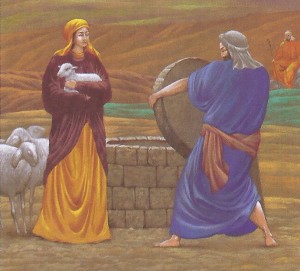
Rachel and Jacob at the well. Artist: Oleg Trabish. Courtesy of Palpnot.
It is at the well is where we often find the women of the Bible – drawing water for home and family as one of their many daily tasks. That made cisterns and springs just about the most important meeting place in any human habitation and as such – the backdrop for some unforgettable biblical encounters. Abraham’s servant deemed Rebecca to be “the one” for Isaac when he saw the energy and strength she put into her well-side work (Gen. 24:14–21) ; It was the best place for Jacob to show how his body-building skills had paid off (Gen. 29:10); Moses meets his future wife Zipporah by the well after fighting off rival water-seeking shepherds (Ex. 2. 16-20) And our ancient sages saw the juxtaposition of the death of Moses’ sister in the wilderness and Israelite clamoring for water (Num. 20: 1–2) as the reason for the appearance of a miraculous spring. And by the way, forever after, “Miriam’s well,” according to legend, appeared whenever her people needed her special brand of sustenance (eventually plunking, just as miraculously, into the Sea of Galilee where if you watch and wait, you can see it bubbling up to this day).
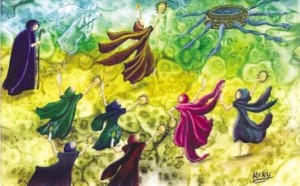
Miriam the prophetess leading praise by the seashore; facing her miraculous spring. Detail of a painting by Riky Rothenberg. Courtesy of Riky Rothenberg.
Water quenches, cleanses, heals, revives and purifies – that was an axiom of our biblical ancestors’ lives. And from there, it’s just a short leap of human understanding to making water the ultimate symbol for spiritual renewal, and for life itself.
I hope you’ll find pleasure in the slide show, “Waters of Joy” that I prepared, which includes photos of my favorite Holy Land springs, rivers and waterfalls, accompanied by biblical verses and is set to part of Handel’s Water Music Suite No. 2 in D.
Here’s wishing us all rains of blessing in 2017, and may we all draw strength from our deepest wellsprings.
Miriam Feinberg Vamosh is the author of a series of books about daily life in the Bible. Her first historical novel, The Scroll , is now in its second printing.


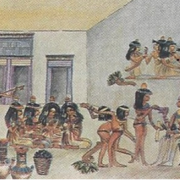


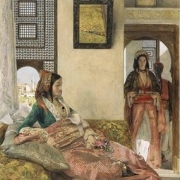
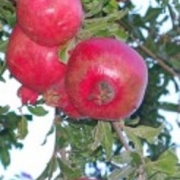

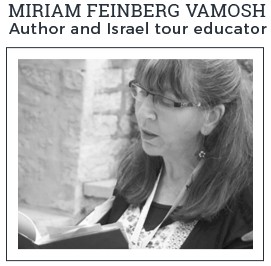
Thanks for this, Miriam. Beautiful. I appreciate your love of the land and the Scripture and your children and grandchildren! Blessings on you. And them.
Thank you so much! And on you and yours!
Oh, what a wonderful, beautiful gift. I will bookmark this to watch over and over again. I was in Israel last year during the rains of December. Such a blessing!
Thank you so much for your heartwarming comment, Gail!
I enjoyed this post — helps to place the right view on our winter-rainy season. We have a lot of season. I loved the slide show! Beautiful, reflective, devotional, peaceful… thank you Miriam!
Thank you, Terry!
Waters of Joy – Refreshment as only the Lord can provide it!!! Thank you for this beautiful presentation. Our hearts long for the beauty of Israel, inwardly and outwardly, the hearts of His People!
And thank you, Sister Georjean for your warm and loving message.